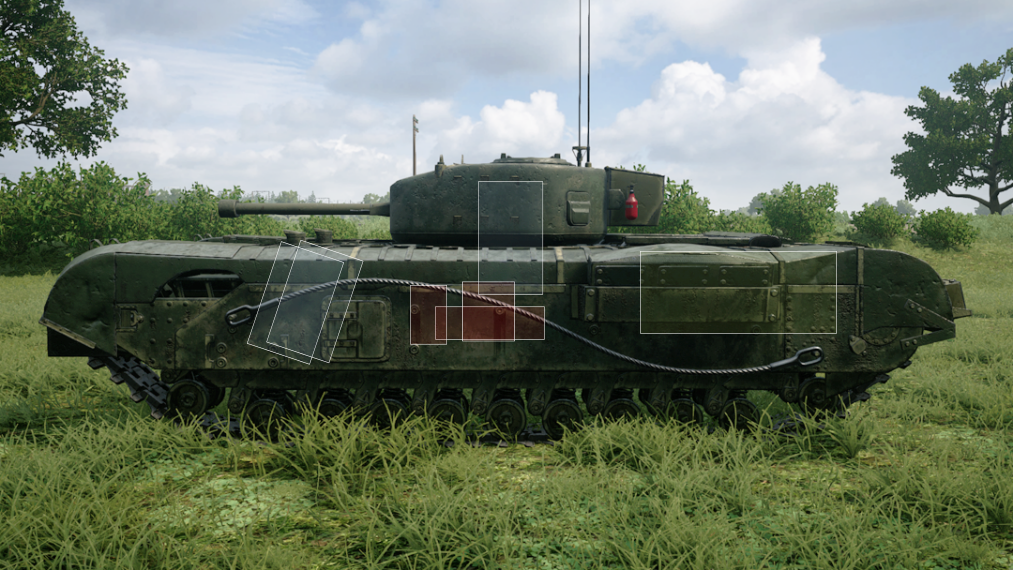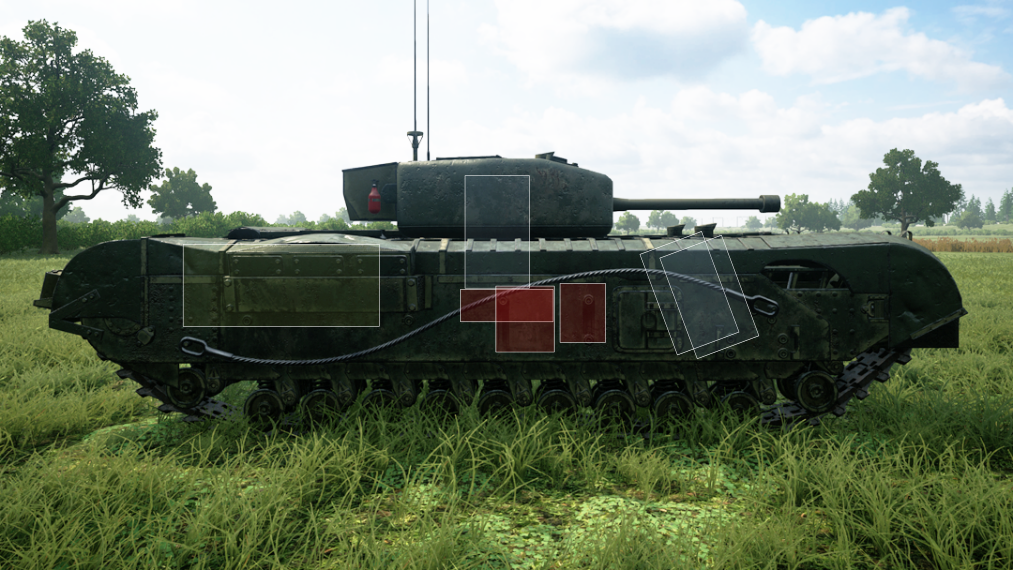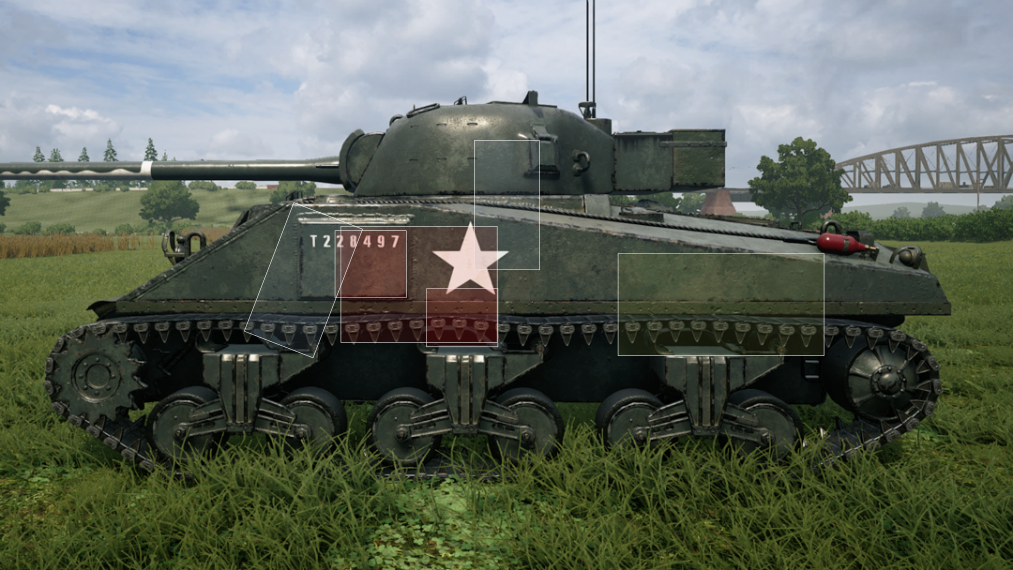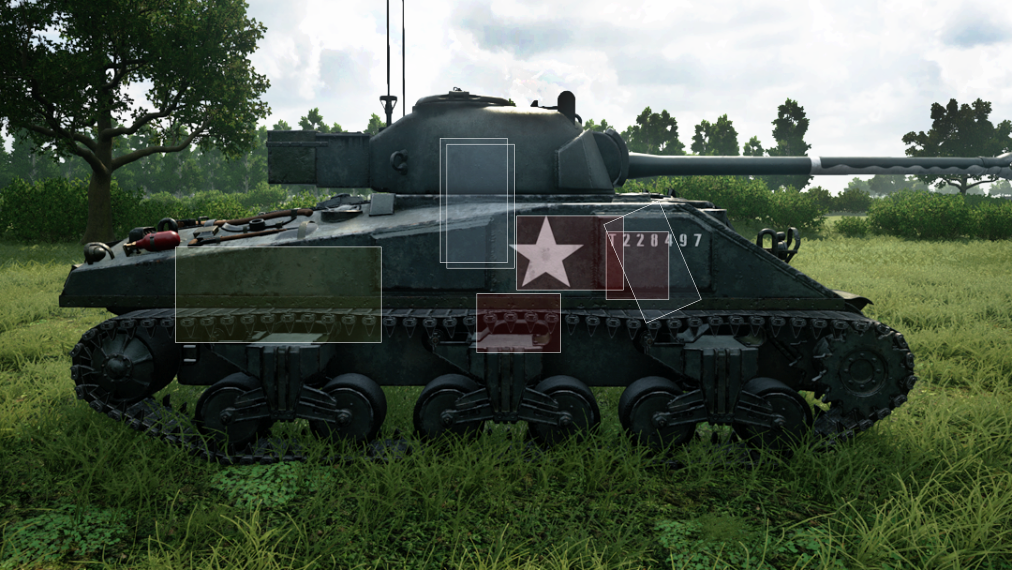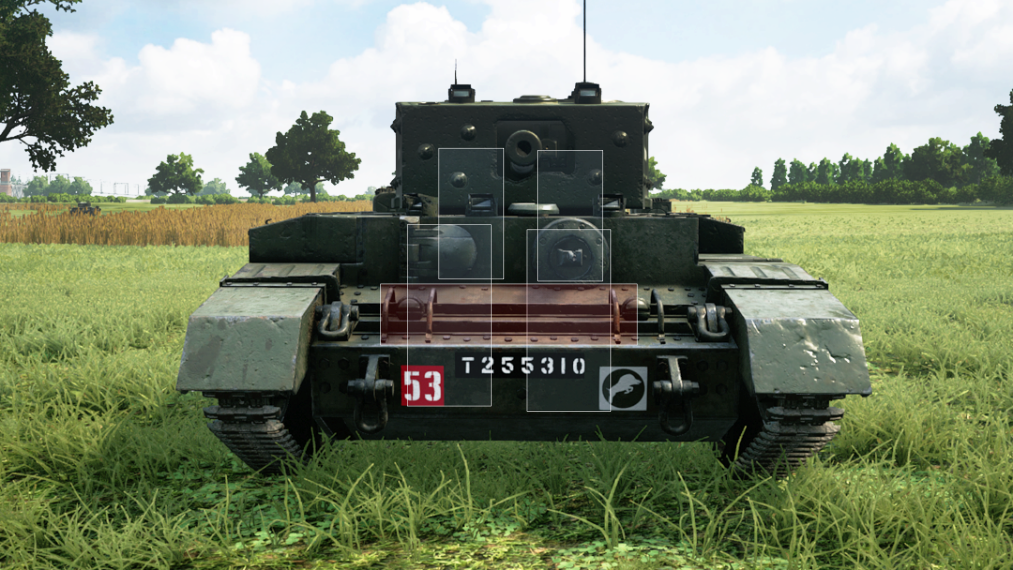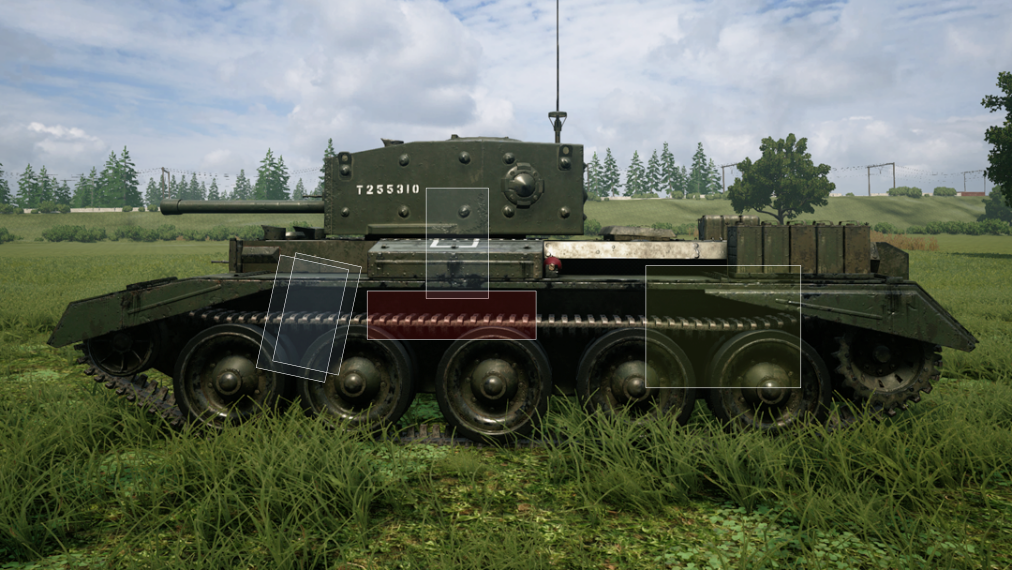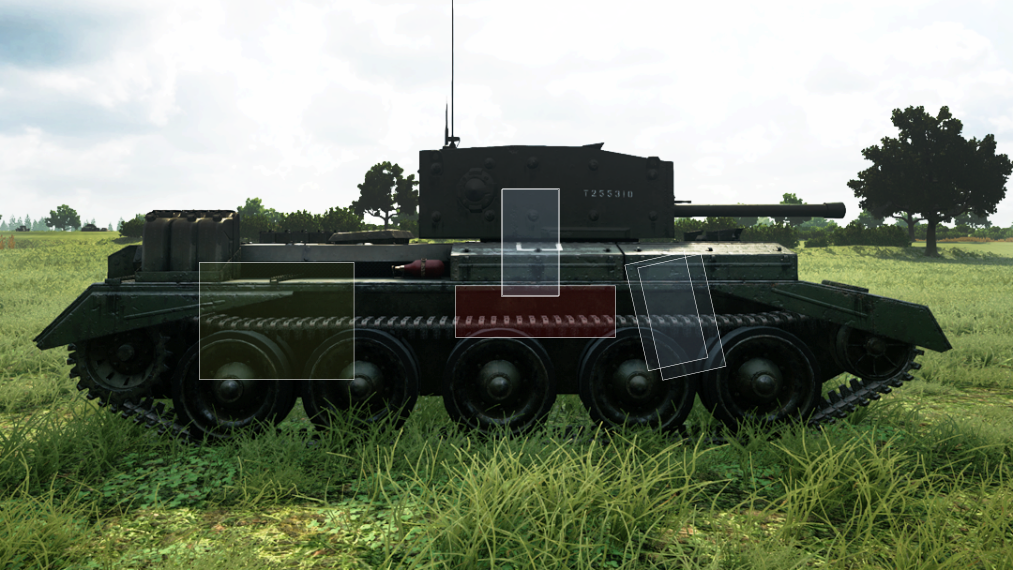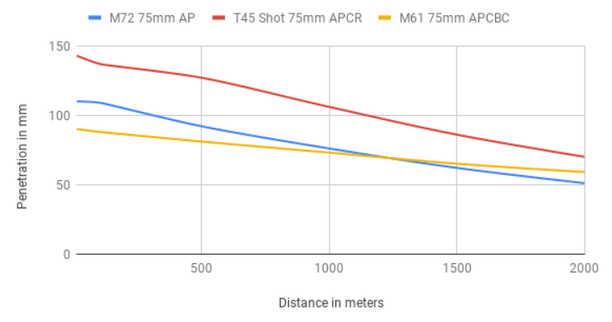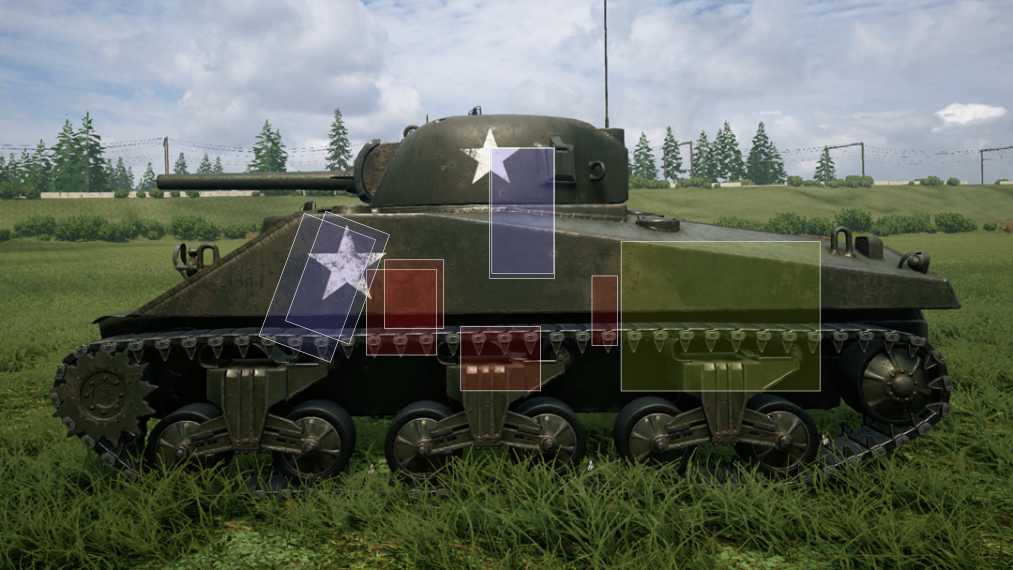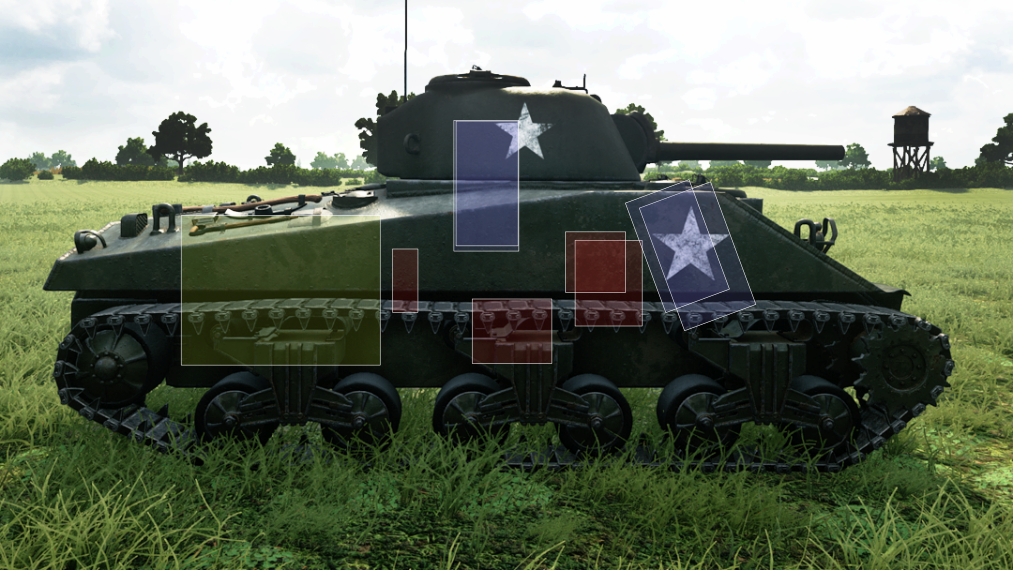VEHICLE RECOGNITION CHARTS
Churchill Mk. IV

- Weight: 40.7 t
- Crew: 5
- Engine: Bedford 12-cylinder
- Main armament: QF 6-Pounder (Co-ax 7.62mm Besa)
- Secondary Armament: Hull MG (7.62 Besa)
The Tank, Infantry, Mk IV (A22) Churchill was a British heavy infantry tank used in the Second World War, best known for its heavy armour, large longitudinal chassis with all-around tracks with multiple bogies, its ability to climb steep slopes, and its use as the basis of many specialist vehicles. It was one of the heaviest Allied tanks of the war.
(Our consensus based on Post Scriptum): In practice this is a fine 'infantry support' vehicle that can sometimes penetrate the front hull of a Tiger tank from short range.
Sherman VC Firefly

- Weight: 35.3 Tonnes
- Dimensions: H: 2.7M | W: 2.64M | L: 7.77M
- Crew: 4
- Engine: Chrysler multi-bank or radial engine
- Main armament: QF 17-lbr (Coax M1919A4 .30 Cal)
The Sherman Firefly was a tank used by the United Kingdom and some Commonwealth and Allied armoured formations in the Second World War. It was based on the US M4 Sherman, but fitted with the powerful 3-inch (76.2 mm) calibre British 17-pounder anti-tank gun as its main weapon. Originally conceived as a stopgap until future British tank designs came into service, the Sherman Firefly became the most common vehicle mounting the 17-pounder in the war.
(Our consensus based on Post Scriptum): The Sherman Firefly is a clan favourite and is a great anti-tank weapon while still serving well as an infantry-support vehicle if the occasion requires.
Mark VIII A27M Cromwell I

- Weight: 28 Tonnes
- Dimensions: W: 2.91M | H: 2.49M | L: 6.35M
- Crew: 5
- Engine: Rolls-Royce Meteor V12
- Main armament: QF 75 mm (Coax 7.62 Besa MG)
- Secondary Armament: 7.62 Besa MG
The Cromwell tank, officially Tank, Cruiser, Mk VIII, Cromwell (A27M), was one of the series of cruiser tanks fielded by Britain in the Second World War. Named after the English Civil War leader Oliver Cromwell, the Cromwell was the first tank put into service by the British to combine high speed from a powerful and reliable engine (the Rolls-Royce Meteor), and reasonable armour. The intended dual-purpose high velocity gun could not be fitted in the turret and the medium velocity dual purpose gun fitted proved inadequate. An improved version with a high velocity gun became the Comet tank.
The name "Cromwell" was initially applied to three vehicles during development. Early Cromwell development led to the creation of the A24 Cavalier. Later Cromwell development led to the creation of the competing Tank, Cruiser, Mk VIII, Centaur (A27L) design. The Centaur tank was closely related to the Cromwell, both vehicles being externally similar. The Cromwell and Centaur tanks differed in the engine used; the Centaur had the 410 hp Liberty engine, the Cromwell had the significantly more powerful 600 hp Meteor.
The Cromwell first saw action in the Battle of Normandy in June 1944. The tank equipped the armoured reconnaissance regiments of the Royal Armoured Corps, in the 7th Armoured Division, 11th Armoured Division and the Guards Armoured Division. While the armoured regiments of the latter two divisions were equipped with M4 Shermans, the armoured regiments of the 7th Armoured Division were equipped with Cromwells. The Centaurs were not used in combat except for those fitted with a 95mm howitzer, which were used in support of the Royal Marines during the amphibious invasion of Normandy.
M4A3 (Sherman IV) 75

- Weight: 30.3 Tonnes
- Dimensions: W: 2.62M | H: 2.74M | L: 6.27M
- Crew: 5
- Engine: Ford GAA V8
- Main armament: 75mm Gun M3 (Coax .30 Cal M1919A4)
- Secondary Armament: .30 Cal M1919A4
The M4 Sherman, officially Medium Tank, M4, was the most widely used medium tank by the United States and Western Allies in World War II. The M4 Sherman proved to be reliable, relatively cheap to produce, and available in great numbers. It was also the basis of several successful tank destroyers, such as the M10, Achilles and M36. Tens of thousands were distributed through the Lend-Lease program to the British Commonwealth and Soviet Union. The tank was named by the British for the American Civil War general William Tecumseh Sherman.
The M4 Sherman evolved from the M3 Medium Tank, which had its main armament in a side sponson mount. The M4 retained much of the previous mechanical design, but moved the main 75 mm gun into a fully traversing central turret. One feature, a one-axis gyrostabilizer, was not precise enough to allow firing when moving but did help keep the reticle on target, so that when the tank did stop to fire, the gun would be aimed in roughly the right direction. The designers stressed mechanical reliability, ease of production and maintenance, durability, standardization of parts and ammunition in a limited number of variants, and moderate size and weight. These factors, combined with the Sherman's then-superior armor and armament, outclassed German light and medium tanks fielded in 1939–42. The M4 went on to be produced in large numbers, being the most produced tank in American history: The Soviets' T-34 medium tank (total of some 64,549 wartime-produced examples, split roughly 55%-45% between 76 mm and 85 mm gunned examples) was the only tank design produced in larger numbers during World War II. The Sherman spearheaded many offensives by the Western Allies after 1942.
M5 Stuart

- Weight: 15.2 Tonnes
- Dimensions: W: 2.29M | H: 2.57M | L: 4.84M
- Crew: 4
- Engine: Twin Cadillac Series 42
- Main armament: 37mm Gun M6 (Coax .30 Cal M1919A4)
- Secondary Armament: .30 Cal M1919A4 (Hull)
The M3 Stuart, officially Light Tank, M3, was an American light tank of World War II. An improved version entered service as M5. It was supplied to British and other Commonwealth forces under lend-lease prior to the entry of the U.S. into the war. Thereafter, it was used by U.S. and Allied forces until the end of the war.
The British service name "Stuart" came from the American Civil War Confederate general J. E. B. Stuart and was used for both the M3 and the derivative M5 Light Tank. In U.S. use, the tanks were officially known as "Light Tank M3" and "Light Tank M5".
To relieve wartime demand for the radial aero-engines used in the M3, a new version was developed using twin Cadillac V8 automobile engines and twin Hydra-Matic transmissions operating through a transfer case. This version of the tank was quieter, cooler and roomier; the automatic transmission also simplified crew training. The new model (initially called M4 but redesignated M5 to avoid confusion with the M4 Sherman[9]) featured a redesigned hull with a raised rear deck over the engine compartment, sloped glacis plate and driver's hatches moved to the top. Although the main criticism from units using the Stuarts was that it lacked firepower, the improved M5 series kept the same 37 mm gun. The M5 gradually replaced the M3 in production from 1942 and, after the M7 project proved unsatisfactory, was succeeded by the Light Tank M24 in 1944. Total M5 and M5A1 tank production was 8,885; an additional 1,778 M8 75 mm howitzer motor carriages based on the M5 chassis with an open-top turret were produced.
T17 Staghound

- Weight: 14 Tonnes
- Dimensions: W: 2.69M | H: 2.36M | L: 5.49M
- Crew: 5
- Engine: 2 × GMC 270
- Main armament: 37 mm M6 (Coax .30 Cal M1919A4)
- Secondary Armament: .30 Cal M1919A4 (Hull)
The T17E1 Armoured Car was an American armored car design produced during the Second World War. While it never saw service with frontline US forces, it was supplied to British and other Commonwealth forces during the war, under the name Staghound. A number of other countries used the Staghound after the war; some vehicles continued to serve until the 1980s.
Daimler Armoured Car

- Weight: 7.6 Tonnes
- Dimensions: W: 2.46M | H: 2.26M | L: 4M
- Crew: 3
- Engine: Daimler 27 4.1 litre 6-cylinder
- Main armament: QF 2-Pounder (Coax 7.62 Besa MG)
The Daimler Armoured Car was a successful British armoured car design of the Second World War that continued in service into the 1950s. It was designed for armed reconnaissance and liaison purposes. During the postwar era, it doubled as an internal security vehicle in a number of countries.
Former British Daimler armoured cars were exported to various Commonwealth of Nations member states throughout the 1950s and 1960s. In 2012, some were still being operated by the Qatari Army.
The Daimler Armoured Car was a parallel development to the Daimler Dingo "Scout car", a small armoured vehicle for scouting and liaison roles. It was another Birmingham Small Arms design. A larger version designed on the same layout as the Dingo fitted with the turret similar to that of the Mark VII Light Tank and a more powerful engine. Like the scout car, it incorporated some of the most advanced design concepts of the time and is considered one of the best British AFVs of the Second World War. The 95 hp engine was at the rear linked through a fluid flywheel to a Wilson preselector gearbox and then a H-drive arrangement with propshafts to each wheel. Four wheel steering similar to early models of the Scout car was considered but not implemented following experience with the Dingo.


